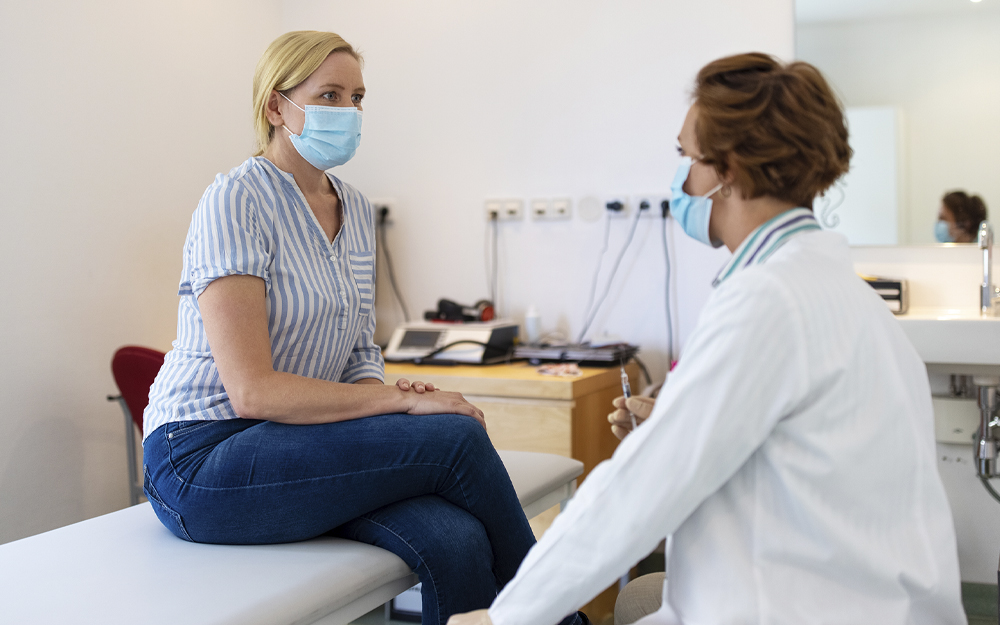What Women Need to Know About Blood Clots
Date
July 14, 2021
Credits

Date
July 14, 2021
Credits
Medical providers featured in this article
In Brief
{{cta-block}}
Blood clots affect up to 900,000 people each year, according to the Centers for Disease Control and Prevention (CDC), and some women are especially vulnerable.
As more and more women are vaccinated against COVID-19, blood clots have also been detected in a small number of women who received the Johnson & Johnson (Janssen) vaccine. After a thorough safety review, the vaccine is available again, but the CDC cautions women under 50 to be aware of their heightened risk for this rare but serious side effect and know that other options exist.

With blood clots in focus, Cedars-Sinai gynecologist Dr. Natasha Schimmoeller explains why you should still get vaccinated and how to think about blood clots, including risk factors, symptoms to watch out for and what they mean for women's health.
"Blood clots are—rightfully so—a scary thing, but fortunately, they're a rare occurrence," Dr. Schimmoeller says.
"Blood clots are—rightfully so—a scary thing, but fortunately, they're a rare occurrence."
Vaccine-linked blood clots are extremely infrequent
With the Johnson & Johnson vaccine, the CDC reports seeing thrombosis with thrombocytopenia syndrome at a rate of about seven cases per 1 million vaccinated women between 18 and 49 years old. The blood clotting condition is even more rare in women over the age of 50.
The side effect has only been observed in the Johnson & Johnson vaccine in the U.S. and Dr. Schimmoeller points out that causality has not been established.
COVID-19 vaccines are still being studied. If you experience an unusual reaction after vaccination, you can report it to the Vaccine Adverse Event Reporting System.
Hormonal birth control can increase risk
Estrogen-containing birth control methods raise your chances of venous thromboembolism by about three or four times compared to women not on the medications, according to the National Blood Clot Alliance.
Risk is further amplified for women who already have other predisposing factors such as a personal or family history of blood clots.
While relative risk is higher, the absolute risk of getting a blood clot when taking birth control remains incredibly low.
"Fractions far less than 1%," Dr. Schimmoeller points out.
And it only applies to the estrogen-containing birth control pill, the patch and the vaginal ring, not progestin only or nonhormonal methods such as the Depo shot, arm implant or an IUD.
Pregnancy and COVID-19 can both lead to blood clots
While pregnant women might be more hesitant to get vaccinated against COVID-19 because of this fear, both pregnancy and the virus that causes COVID-19 have also been tied to blood clots.
Pregnancy and childbirth raise the likelihood of blood clots for up to three months after a baby is born, according to the CDC, with the threat even higher in the immediate postpartum period. As with birth control, pregnancy risk grows alongside other factors such as a family or personal history of clots, being overweight or obese, a pregnancy at age 35 or older and delivery by cesarean section.
"In ascending risk of blood clots, the COVID-19 vaccine would be lowest-risk, then hormonal contraceptives, then pregnancy," Dr. Schimmoeller says. "And the final end of that would be COVID-19."
The CDC recommends pregnant and breastfeeding women get vaccinated against COVID-19.
Take blood clots seriously
Blood clots can occur in the brain. They can also form in a deep vein (usually your leg or arm) and, if left unchecked, travel from a deep vein to a lung (pulmonary embolism). Venous thromboembolism frequently recurs within 10 years, according to the CDC.
The condition can be manageable and treatable, experts say. But it's underdiagnosed—and can also be a dangerous medical emergency, tied to strokes, heart attacks, disability and death: Up to 100,000 people die from blood clots annually.
Smoking, undergoing hospitalization or surgery, being overweight, immobile or sitting for long periods of time, having cancer and experiencing physical trauma—especially a vein injury—can all make you more vulnerable to a blood clot.
"It's a very wide spectrum—it really depends on where the clot is and what's going on medically with the individual," Dr. Schimmoeller says.
"Being up and active keeps circulation moving"
Watch out for symptoms
A blood clot in your arms or legs can cause:
- Localized swelling
- Warm or red skin with pain
- Pain or tenderness not caused by a known injury
If you notice any of these symptoms, call your primary care doctor. Early diagnosis is crucial.
Symptoms of a pulmonary embolism include:
- Difficulty breathing
- Chest pain that gets worse with a deep breath
- Coughing up blood
- Fast or irregular heartbeat
- Very low blood pressure, lightheadedness or fainting
Any of these symptoms require immediate medical attention in an emergency department.
Cedars-Sinai's pulmonary embolism response team assesses and treats cases using experts from a range of fields including pulmonology, radiology, cardiology and internal medicine.
Talk to your doctor directly
Don't let blood clots catch you by surprise: Many are preventable and treatable—if caught early enough.
Discuss risk factors and how best to protect yourself with your primary care provider, as well as with your doctor before any surgery.
For patients who are at high risk due to certain medical conditions, doctors can prescribe prophylactic blood thinning medications to help prevent blood from clotting.
Your OB-GYN should also consider your medical and family history to make sure it's safe before prescribing a contraceptive method or other estrogen-containing medication. And don't be afraid or embarrassed to bring up any questions or concerns.
You can also make lifestyle adjustments such as quitting smoking, staying hydrated, wearing compression stockings for flights and moving around every few hours. Experts suggest breaking up travel or other long periods of sitting still with stretches, walks and calf activities such as extending your legs and pulling your toes toward you.
"Being up and active keeps circulation moving," Dr. Schimmoeller says.





